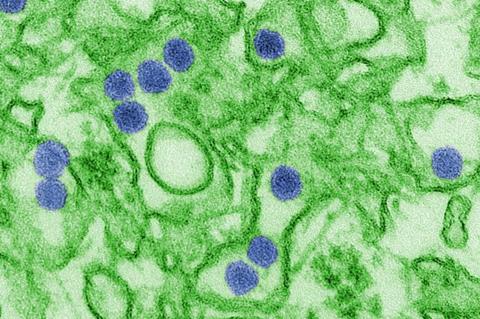Zika virus infection in pregnant rhesus macaques slows fetal growth and affects how infants and mothers interact in the first month of life, according to a new study from researchers at the California National Primate Research Center at the University of California, Davis.

The work, published in Science Translational Medicine, has implications for both humans exposed to Zika virus and for other viruses that can cross the placenta, including SARS-CoV2, responsible for the COVID-19 pandemic.
“Initially I thought this was a story about Zika, but as I looked at the results I think this is also a story about how fetal infections in general affect developmental trajectories,” said Eliza Bliss-Moreau, professor of psychology at UC Davis and senior author on the paper.
Crossing the placenta
In most people, Zika virus infection causes mild or no symptoms and leaves long-lasting immunity. But during pregnancy, the virus can cross the placenta and cause damage to the nervous system of the fetus. In extreme cases, it can cause microcephaly in humans.
While no local transmission of the virus has been reported in the U.S. since 2018, the mosquitoes that carry Zika virus continue to expand their range throughout Africa, the Americas, Asia and the Pacific.
UC Davis researchers previously showed that Zika virus could enter the fetal brain in pregnant macaques. The new study, led by Bliss-Moreau with Associate Specialist Gilda Moadab, Project Scientist Florent Pittet and colleagues at the CNPRC and UC Davis Department of Psychology, looked at the effects of Zika infection during the second trimester of pregnancy on infants up to a month after birth.
Second trimester
Pregnant animals did not become visibly ill with the virus, but ultrasounds showed fetal growth slowed after infection, Pittet said. At birth, Zika-exposed infants were “at the low end” of the range for head size in rhesus macaques.
“They were smaller overall,” he said. Higher levels of circulating Zika virus corresponded with longer delays in growth.
After birth, the researchers tracked the development of sensory and motor skills – using tests similar to those used for human babies – and interaction with the mother.
“The trajectory was quite different,” Pittet said. Right after birth, infant monkeys spend a lot of time on their mother but start to separate after about two weeks. But the Zika infants spent much more time clinging to their mothers through the first month.
It’s not clear whether the mother or the infant is initiating this contact, Bliss-Moreau said.
“We know that moms will keep hold of infants that are having challenges,” she said.
Males more affected
Surprisingly, growth delays and effects on mother-infant interactions were greater in male than in female infants, although both showed delays compared to uninfected controls. Infectious disease studies in animals tend to use one sex (usually male) to avoid confounding effects, but potentially missing such sex differences.
Additionally, the animals were housed in established social groups of multiple adult females (including their mother), a single male and other male and female infants of about the same age. This allows the infants to learn from each other and from the adults, Pittet said.
“The presence of unrelated adults and infants in the social group is a critical factor for normative development,” he said. “Offering such a social rearing environment is tons of additional work but ensures a lot more relevance to developmental studies.”
Cascade of consequences
Upcoming papers will describe the monkeys’ growth through the first two years of life. Zika virus exposure during pregnancy sets off a cascade of consequences that may not appear until later in development, Pittet said.
The finding that outcomes correlate with viral load during pregnancy offers opportunities to intervene, the researchers said. A drug or vaccine would not have to completely eliminate the virus to be beneficial. This may be generally true for other infections that can affect the fetus, such as COVID.
“Anything you can do to reduce viral load is a good thing for infant development,” Bliss-Moreau said. A 2019 study by CNPRC scientists, in collaboration with the National Institute of Allergy and Infectious Diseases, found that an experimental Zika vaccine lowered levels of circulating viruses in pregnant macaques.
Additional coauthors are: Jeffrey Bennett, Christopher Taylor, Olivia Fiske and Koen van Rompay at the CNPRC; and Anil Singapuri and Lark Coffey, UC Davis School of Veterinary Medicine. The work was supported by grants from the National Institutes of Health.







No comments yet